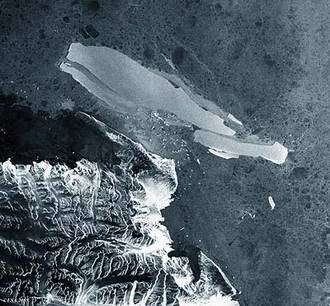Iceberg B15A no longer Earth's largest

What was the Earth's largest free-floating object for five years -- the B-15A iceberg -- has broken into smaller pieces off Antarctica's Cape Adare.
Image: The break-up of B-15A in progress off Cape Adare on 30 October 2005, as seen Envisat's ASAR in Wide Swath Mode. Credits: ESA
The European Space Agency says its Envisat satellite has been tracking the movement of the drifting ice continuously since the beginning of this year.
ESA scientists say the most recent imagery shows the bottle-shaped iceberg split into nine knife-shaped icebergs and a myriad of smaller pieces on Oct. 27-28.
Measuring, until last week, around 71 miles (115 kilometers) in length, the B-15A tabular iceberg apparently ran aground off Cape Adare, the northernmost corner of the Victoria Land Coast, the Paris-headquartered ESA said. That apparently led to the flexing and straining that resulted in the break-up.
B-15A had been the largest remaining section of the even larger B-15 iceberg that calved from the nearby Ross Ice Shelf in March 2000 before breaking up into smaller sections off McMurdo Island.
Copyright 2005 by United Press International

















